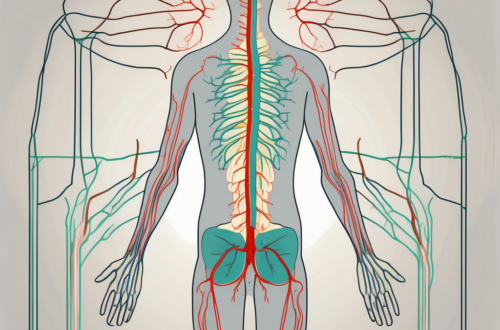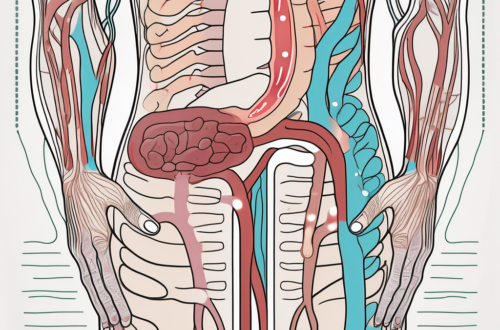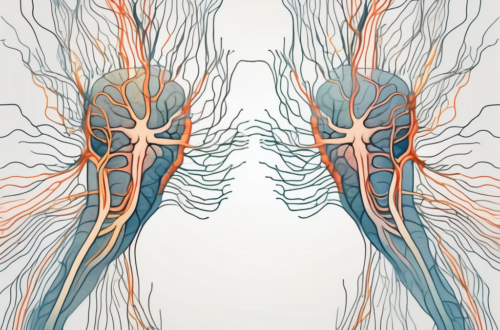The parasympathetic nerve supply of the stomach plays a vital role in its function and regulation. To truly understand the complexity of this system, it is important to have a comprehensive overview of the parasympathetic nervous system as well as an understanding of the anatomy of the stomach itself. In this article, we will explore these concepts in detail, discuss the implications of parasympathetic activity on stomach function, examine disorders related to parasympathetic nerve supply, and highlight future research directions in this fascinating field.
An Overview of the Parasympathetic Nervous System
The parasympathetic nervous system is one of the two divisions of the autonomic nervous system, which controls involuntary bodily functions. It works in opposition to the sympathetic nervous system, balancing its effects to maintain homeostasis within the body. While the sympathetic nervous system is responsible for the “fight or flight” response, the parasympathetic nervous system is involved in promoting rest, relaxation, and digestion.
The parasympathetic nervous system plays a crucial role in maintaining the body’s overall well-being. It is responsible for regulating various bodily processes during times of rest and recovery. By conserving energy and promoting optimal functioning of organs, the parasympathetic nervous system ensures that the body can recuperate and function efficiently.
One of the key functions of the parasympathetic nervous system is its involvement in digestion. When activated, it stimulates the digestive system, enhancing the breakdown of food and absorption of nutrients. This process is essential for providing the body with the necessary energy and building blocks for growth and repair.
Role and Function of the Parasympathetic Nervous System
The primary role of the parasympathetic nervous system is to regulate body processes during times of rest and recovery. It helps conserve energy and promotes optimal functioning of various organs, including the stomach. When activated, the parasympathetic nervous system stimulates digestion, enhances nutrient absorption, and promotes waste elimination.
Furthermore, the parasympathetic nervous system is responsible for promoting relaxation and reducing stress. It counteracts the effects of the sympathetic nervous system, which triggers the body’s “fight or flight” response. By activating the parasympathetic nervous system, the body can return to a state of calm and rest, allowing for rejuvenation and restoration.
In addition to its role in digestion and relaxation, the parasympathetic nervous system also influences other bodily functions. It regulates heart rate, promoting a slower and more regular rhythm. It also stimulates salivation, which aids in the digestion process by moistening food and facilitating swallowing.
Components of the Parasympathetic Nervous System
The parasympathetic nervous system consists of numerous components that work together to achieve its regulatory functions. These components include various cranial nerves and specific ganglia located near or within target organs. However, the vagus nerve stands out as the main parasympathetic supply to the stomach.
The vagus nerve, also known as the tenth cranial nerve, is the longest and most complex of the cranial nerves. It originates in the brainstem and extends down to the abdomen, innervating multiple organs along the way. In the context of the parasympathetic nervous system, the vagus nerve plays a crucial role in regulating digestion and gastrointestinal functions.
Within the gastrointestinal tract, the vagus nerve branches out extensively, forming a dense network of nerve fibers. These fibers innervate the stomach, pancreas, liver, and intestines, among other organs. By sending signals to these organs, the vagus nerve coordinates the parasympathetic response, ensuring proper digestion, nutrient absorption, and waste elimination.
In summary, the parasympathetic nervous system is a vital component of the autonomic nervous system. It promotes rest, relaxation, and digestion, helping the body maintain balance and optimal functioning. With its intricate network of components, including the vagus nerve, the parasympathetic nervous system plays a crucial role in regulating various bodily processes, contributing to overall health and well-being.
The Stomach and its Nervous Supply
Before delving into the parasympathetic nerve supply of the stomach, it is important to understand the anatomy of this vital organ and its relationship with the nervous system.
Anatomy of the Stomach
The stomach is a highly specialized muscular organ located between the esophagus and the small intestine. It plays a crucial role in the digestion of food by secreting enzymes and acids, as well as mixing and propelling the contents through peristalsis. It consists of several anatomical regions, including the fundus, body, antrum, and pylorus.
The fundus is the uppermost part of the stomach, which acts as a temporary storage area for food before it is gradually released into the rest of the organ. The body of the stomach is the main central region where most of the digestion takes place. It is lined with gastric glands that secrete hydrochloric acid and enzymes, such as pepsin, that break down proteins. The antrum is the lower portion of the stomach, responsible for grinding and mixing the partially digested food with gastric juices. Finally, the pylorus is the narrow passage that connects the stomach to the small intestine, controlling the release of food into the duodenum.
The Nervous System and the Stomach
The stomach is closely interconnected with the nervous system, which regulates its activity and ensures its proper functioning. Both the sympathetic and parasympathetic divisions of the autonomic nervous system contribute to this regulation. While the sympathetic nervous system inhibits gastric activity, the parasympathetic nervous system stimulates it, thereby playing a crucial role in digestion and other stomach functions.
The parasympathetic nerve supply to the stomach is primarily provided by the vagus nerve, also known as the tenth cranial nerve. The vagus nerve originates in the brainstem and extends down into the abdomen, innervating various organs along the way, including the stomach. It releases the neurotransmitter acetylcholine, which binds to receptors on the stomach’s smooth muscle cells, causing them to contract and increase gastric motility.
In addition to the vagus nerve, the stomach also receives sympathetic innervation from the thoracic splanchnic nerves. These nerves arise from the sympathetic chain ganglia in the thoracic region of the spinal cord and travel to the stomach, where they release norepinephrine. Norepinephrine acts on adrenergic receptors in the stomach, inhibiting gastric motility and reducing blood flow to the organ.
Furthermore, the stomach contains an extensive network of enteric neurons, also known as the “second brain.” These neurons form the enteric nervous system, which is capable of independently regulating the functions of the gastrointestinal tract. The enteric nervous system receives input from both the sympathetic and parasympathetic divisions of the autonomic nervous system, as well as from sensory neurons that detect changes in the stomach’s environment.
Overall, the intricate interplay between the parasympathetic and sympathetic divisions of the autonomic nervous system, along with the enteric nervous system, ensures the proper functioning of the stomach. This coordination allows for the timely release of digestive enzymes and acids, efficient mixing and propulsion of food, and the regulation of blood flow to support the digestive process.
The Parasympathetic Nerve Supply of the Stomach
When it comes to the parasympathetic nervous system, the vagus nerve takes center stage as the primary supplier of parasympathetic innervation to the stomach. The vagus nerve, scientifically known as the tenth cranial nerve, originates in the brainstem and extends its intricate network of fibers towards various organs, including the stomach.
The vagus nerve exerts its profound influence on the stomach by releasing a vital neurotransmitter called acetylcholine. This neurotransmitter binds to specific receptors on the surface of stomach cells, triggering a cascade of effects that play a crucial role in the digestive process. One of the notable effects of this interaction is the increase in gastric secretions, including gastric acid and digestive enzymes. This surge in secretions helps break down food particles into smaller, more manageable components, facilitating efficient nutrient absorption.
Vagus Nerve: The Main Parasympathetic Supply
The vagus nerve, with its extensive reach and intricate connections, acts as the main conduit for parasympathetic stimulation of the stomach. Its role in regulating stomach function cannot be overstated. By releasing acetylcholine, the vagus nerve initiates a series of events that optimize the digestive process.
Upon binding to receptors on stomach cells, acetylcholine triggers a domino effect, leading to increased gastric secretions and enhanced motility. The heightened secretion of gastric acid, digestive enzymes, and mucus aids in the breakdown of food and the subsequent absorption of nutrients. Additionally, the stimulation of stomach muscles promotes peristalsis, the rhythmic contractions that propel food along the digestive tract.
Mechanism of Parasympathetic Control in the Stomach
The mechanism by which the parasympathetic nervous system exerts control over stomach function is a fascinating interplay of hormonal, neural, and local factors. Activation of the vagus nerve sets off a complex chain of events that optimize the digestive process and ensure the stomach’s efficient functioning.
Upon stimulation, the vagus nerve triggers the release of various substances, including gastrin. Gastrin is a hormone that plays a pivotal role in gastric acid secretion. Its release, stimulated by parasympathetic activity, further enhances the production of gastric acid, facilitating the breakdown of food particles and aiding in the digestion of proteins.
In addition to its influence on gastric secretions, the parasympathetic nervous system also promotes blood flow to the stomach. This increased blood flow ensures efficient nutrient delivery and waste removal, contributing to the overall digestive process.
The parasympathetic nerve supply of the stomach is a remarkable example of the intricate control mechanisms that govern our bodily functions. The vagus nerve, with its extensive network and release of acetylcholine, plays a pivotal role in optimizing stomach function, ensuring that our bodies can efficiently extract the nutrients we need from the food we consume.
Impact of Parasympathetic Activity on Stomach Function
The parasympathetic nervous system exerts significant influence on stomach function, affecting various aspects of digestion and overall gastrointestinal health.
The parasympathetic nervous system, often referred to as the “rest and digest” system, is responsible for promoting relaxation and facilitating the body’s ability to break down and absorb nutrients from food. It works in contrast to the sympathetic nervous system, which is responsible for the body’s “fight or flight” response.
Parasympathetic Stimulation and Digestion
Parasympathetic stimulation plays a pivotal role in initiating and maintaining the digestive process. By increasing gastric secretions and motility, parasympathetic activity facilitates the breakdown of food, aiding in the absorption of nutrients. This stimulation occurs through the release of acetylcholine, a neurotransmitter that binds to receptors in the stomach lining, triggering a cascade of events that promote digestion.
When the parasympathetic nervous system is activated, it sends signals to the stomach to increase its production of digestive enzymes, such as pepsin and lipase, which are essential for breaking down proteins and fats, respectively. Additionally, parasympathetic stimulation promotes the release of hydrochloric acid, which helps to create an acidic environment in the stomach that is necessary for the activation of digestive enzymes and the killing of harmful bacteria.
However, it is important to note that excessive stimulation or dysregulation of parasympathetic activity can result in digestive disorders. For example, overactive parasympathetic activity can lead to increased gastric acid production, which can cause conditions such as gastroesophageal reflux disease (GERD) or peptic ulcers.
Parasympathetic Influence on Stomach Motility and Secretion
The parasympathetic nervous system plays a key role in regulating stomach motility, ensuring efficient movement of food through the digestive tract. It does this by stimulating the contraction of smooth muscles in the stomach walls, which helps to mix and propel food along the digestive tract.
In addition to regulating stomach motility, the parasympathetic nervous system also stimulates the secretion of gastric juices, including hydrochloric acid and enzymes necessary for digestion. These secretions are crucial for breaking down food into smaller particles that can be absorbed by the body. Dysfunction or imbalances in parasympathetic activity can disrupt these processes, leading to conditions such as gastroparesis, a condition characterized by delayed stomach emptying.
Furthermore, the parasympathetic nervous system also influences the release of hormones that play a role in digestion, such as gastrin, which stimulates the production of gastric acid, and ghrelin, which stimulates hunger. These hormones work in conjunction with parasympathetic activity to regulate the overall digestive process.
In conclusion, the parasympathetic nervous system plays a crucial role in regulating stomach function and digestion. Its stimulation promotes the secretion of digestive enzymes and gastric juices, as well as regulates stomach motility. However, it is important to maintain a balance in parasympathetic activity to avoid digestive disorders and ensure optimal gastrointestinal health.
Disorders Related to Parasympathetic Nerve Supply in the Stomach
When the parasympathetic nerve supply to the stomach is disrupted or impaired, various disorders can arise, causing significant discomfort and impacting overall quality of life.
The parasympathetic nervous system plays a crucial role in regulating the functions of the stomach. It is responsible for stimulating the release of digestive enzymes and promoting the movement of food through the gastrointestinal tract. However, when there is a dysfunction in the parasympathetic nerve supply, the normal functioning of the stomach can be disrupted, leading to the development of various disorders.
Gastroparesis: A Case of Parasympathetic Dysfunction
Gastroparesis is a condition characterized by delayed gastric emptying due to impaired parasympathetic control of stomach motility. In individuals with gastroparesis, the stomach muscles do not contract properly, leading to a delay in the movement of food from the stomach to the small intestine.
People with gastroparesis often experience symptoms such as nausea, vomiting, bloating, and early satiety. These symptoms can significantly impact their quality of life and may require medical intervention for proper management.
While the causes of gastroparesis can vary, parasympathetic dysfunction is often implicated in its development. In some cases, diabetes, neurological disorders, or certain medications can affect the parasympathetic nerve supply to the stomach, leading to gastroparesis.
If you suspect that you may have gastroparesis or are experiencing symptoms such as persistent nausea and vomiting, it is important to consult with a healthcare professional for proper diagnosis and management. They can perform diagnostic tests, such as gastric emptying studies, to evaluate your stomach’s motility and determine the most appropriate treatment plan.
Treatment and Management of Parasympathetic Disorders
The treatment and management of parasympathetic disorders related to the stomach often involve a multidisciplinary approach. It is important to address the underlying cause of the parasympathetic dysfunction, if possible, to effectively manage the associated disorders.
Lifestyle modifications, such as eating smaller, more frequent meals and avoiding foods that are difficult to digest, can help alleviate symptoms in some cases. Additionally, dietary changes, such as increasing fiber intake and staying hydrated, may also be beneficial.
In certain situations, medications may be prescribed to help improve stomach motility and reduce symptoms. These medications can include prokinetic agents, which stimulate the muscles in the gastrointestinal tract, or antiemetics, which help control nausea and vomiting.
In severe cases of parasympathetic disorders, where conservative measures are not effective, surgical interventions may be considered. Surgical options can include gastric electrical stimulation, where a device is implanted to help regulate stomach contractions, or pyloroplasty, a procedure to widen the opening between the stomach and small intestine.
It is important to note that each individual’s situation is unique, and a healthcare professional should be consulted for personalized advice and guidance. They can assess your specific condition, consider any underlying factors, and develop a comprehensive treatment plan tailored to your needs.
Future Research Directions in Parasympathetic Nervous System and Stomach Function
The complex interplay between the parasympathetic nervous system and stomach function continues to be an area of active research. Scientists and medical professionals are constantly striving to deepen our understanding of this intricate relationship and explore potential therapeutic approaches for related disorders.
Potential Therapeutic Approaches
Advancements in medical research have paved the way for potential therapeutic approaches targeting parasympathetic dysregulation in stomach-related disorders. These include pharmacological interventions, such as medications that enhance parasympathetic activity or target specific receptors involved in stomach regulation. Additionally, non-pharmacological interventions like neuromodulation techniques are also being explored.
Unanswered Questions in the Field
Despite significant progress, there are still numerous unanswered questions surrounding the parasympathetic nervous system and its role in stomach function. Further research aims to elucidate the precise mechanisms by which parasympathetic activity modulates stomach physiology and to uncover potential novel therapeutic targets. By addressing these knowledge gaps, we can enhance our understanding of this intricate neural network and develop more effective strategies for managing related disorders.
In conclusion, understanding the parasympathetic nerve supply of the stomach is crucial for comprehending its intricate regulation and function. The vagus nerve, as the primary parasympathetic supply, influences a range of processes in the stomach, contributing to digestion and overall gastrointestinal health. However, disturbances in parasympathetic activity can result in disorders like gastroparesis, impacting quality of life. Ongoing research in this field holds promise for the development of novel therapeutic approaches and a deeper understanding of the intricacies of the parasympathetic nervous system and stomach function. As with any health-related concerns, it is always prudent to consult with a healthcare professional for personalized medical advice and guidance.





